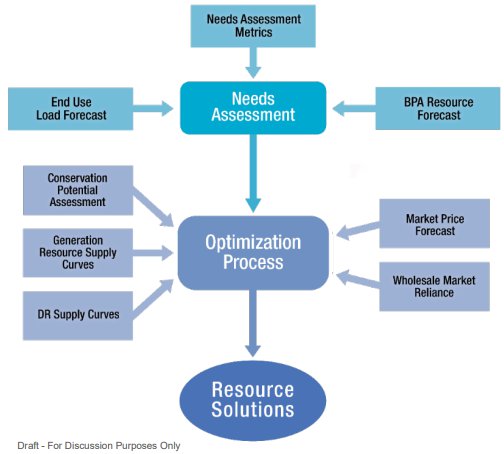Bonneville’s Resource Program
- June 21, 2022
- Jennifer Light

Ensuring the future reliability of the Northwest electric power system while complying with policy goals implemented throughout the West to reduce carbon emissions, such as emissions from power plants that burn fossil fuels, is “a challenging process” involving “a mind-spinning array of uncertainties,” in the words of two members of the Council’s Power Committee.
But as difficult as it is, it is a necessary decision process to ensure the power supply remains reliable as the region – and the nation – rely increasingly on sources of electricity that don’t produce carbon.
The challenge, as Power Committee Chairman Jim Yost, an Idaho member, described it is that non-thermal electricity generators, like solar and wind, have a variable supply of fuel – wind and sunshine. Selecting supplies of electricity that have the best chance of ensuring a reliable supply in the future involves investigating a “mind-spinning” number of choices, Power Committee member KC Golden, a Washington member, said.
The Council grappled with these complexities in developing its resource strategy in the 2021 Northwest Power Plan for the region and Bonneville. This strategy meets future forecasted demand with resources that don’t emit carbon. Bonneville is in the process of developing its Resource Program, which helps to inform its acquisition strategies consistent with the Council plan. As part of its analysis, Bonneville analysts also are seeing similar trends despite these complexities.
At the June Power Committee meeting, Ryan Egerdahl and Torsten Kieper of Bonneville provided an update on the agency’s Resource Program. The timeframe for Bonneville’s next Resource Program is 2024-2033, which aligns with the beginning of the next two-year Bonneville rate case in 2024. Egerdahl said the current resource program study shows the lowest-cost portfolio selecting energy efficiency and demand response. Bonneville also shared other portfolios that seek to reduce risk against market prices. These show increased energy efficiency and demand response, as well as some need for resources like solar and offshore wind in later years of the study. These results are an input into Bonneville’s resource acquisition strategy, which by law must be consistent with the Council’s 2021 Power Plan.
The power plan, which the Council completed in February, includes these resource-acquisition recommendations to Bonneville:
- Acquire between 270 and 360 average megawatts of cost-effective energy efficiency by the end of 2027, of which at least 243 average megawatts must be from programmatic savings, and at least 865 average megawatts by 2041
- Encourage its customer utilities to pursue low-cost and high-value demand response, including time-of-use rates and demand voltage regulation
- Look to mid-term and long-term market resources for additional energy, when the need for power is greater than the recommended energy efficiency and demand response resources
- Compare the price and capacity of electricity available in the wholesale market to renewable power purchase agreements to ensure that the lowest-cost resources that suffice to meet any need are identified
There is a lot of uncertainty about future demand for power, which will be affected by the choices made by ratepayers of Bonneville’s customer utilities. This adds a layer of uncertainty because Bonneville’s current power-sales contacts with its customers expire in 2028.
“Our current view is that by 2025 we will have a much better idea of what our customers will choose post-2028,” Egerdahl said. “Loads could be extremely higher or could swing the other way. We should know within three years.”
Golden said he was glad to see that Bonneville’s resource strategy target for future power demand is in the same range as the target in the Council’s power plan – low end of the range, but within the range. He also recognized that some of the efficiency identified, such as residential heating, ventilation, and air conditioning, is for measures that are not cost-effective in the Council’s plan. He encouraged Bonneville to ensure there is sufficient budget to acquire all the cost-effective energy efficiency in the plan, in addition to any other efficiency that Bonneville might want to pursue for other benefits. He also suggested considering co-funding for the more expensive energy efficiency.
“You want to err on the side that the worst thing that happens is that you spend a little more,” he said. “I don’t want to see us in a position where we can’t respond effectively.”



